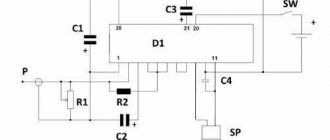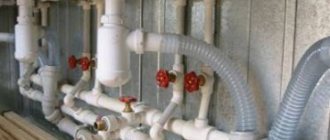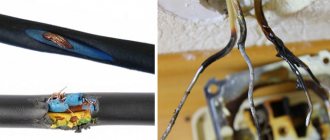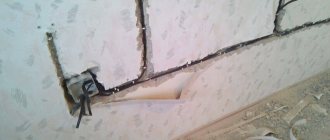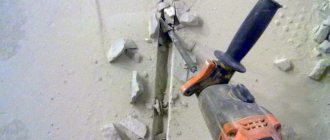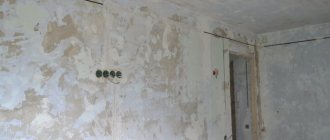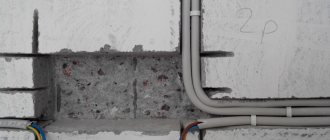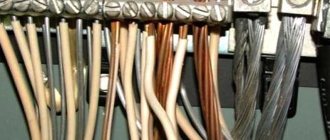Rules, orders and PUE for aluminum and copper wiring
Aluminum wiring
In accordance with the amendments adopted in 2021, wiring in residential premises can be made from aluminum and copper cables.
However, it is not aluminum wires from the 60-70s that are suitable for use, but modern alloys with some iron content. The main thing is to comply with the requirements given in the table.
| Line name | Smallest cross-section of cables and wires, mm.kv | |
| With cores made of aluminum alloys | With copper wires | |
| Group network lines | 2,5 | 1,5 |
| Distribution network lines for supplying residential premises (risers) | 6 | 4 |
| Lines from floor to apartment boards and to the settlement meter | 4 | 2,5 |
Prohibition of aluminum wiring in the apartment
Old-style aluminum wiring is prohibited from being used due to its recognition as a potential fire hazard.
In accordance with international standards, old-style aluminum wiring is recognized as potentially fire hazardous, and therefore its installation is prohibited. Several facts that confirm this:
- There have been numerous cases of fires around the world caused by aluminum wiring. As a result, more than a dozen people were killed.
- According to statistics, in apartment buildings and country houses with an aluminum electrical network, the frequency of spontaneous combustion is 55 times higher than the number of fires in rooms with electrical wires made of other materials.
- According to chapter 7.1. PUE. Clause 7.1.34 this type of wiring is permitted for use only in structures that were built before 2001.
- To prevent fire? It is prohibited to connect copper and aluminum wiring, for example by twisting.
Old-style aluminum wiring was prohibited from use for good reason. There are more reliable and affordable materials that will prevent spontaneous combustion under increased load.
Basic operating requirements
If you nevertheless decide to use aluminum wiring in an apartment or private house, consider the following requirements:
- Cross section of at least 16 square meters. mm (we already talked about this, but it wouldn’t hurt to remind you).
- Use clamp contacts (as well as a special lubricant that will prevent contact oxidation and keep contact resistance low).
- Use welding of aluminum electrical wires in distribution boxes (requires a large investment of time and money, so it is rarely used). If you do not carry out the work yourself, monitor the work of electricians in your home and monitor the process to ensure that all technical aspects are adhered to.
It will also be useful for you to know the maximum load on aluminum wires of different sections. We provided all the data in the table:
And remember, regardless of the type of wiring in your home, adhere to fire and electrical safety rules, as well as operating rules. This way you can protect your family and your home from unwanted consequences and accidents. Finally, we recommend watching another useful video
When installing new wiring, the owner of the premises strives to do everything so as not to return to this operation, therefore, when carrying out repairs or during the construction process, he is always interested in how long the service life of the wire is. At the same time, confusion often arises in defining the very concept of service life - designers, cable manufacturers and electricians operate with different numbers. Therefore, first, let’s define the terminology.
Properties of aluminum wiring
Aluminum wiring is resistant to mechanical stress
Aluminum is not the best option for indoor wiring, but the material has several advantages over its analogues. We are talking about low weight, which greatly simplifies installation work, provided that a large amount of aluminum cable is required. The cost is lower compared to copper. These two main advantages became decisive when choosing types of wiring during the construction of structures in the USSR.
Another important feature of the material is its resistance to corrosion. However, aluminum is highly oxidized when exposed to air. As a result, a film is formed that serves as protection against further damage to the wiring. This film has poor conductivity, which can be attributed to another disadvantage.
Compared to aluminum wiring, it is better to give preference to copper wiring for the following reasons:
- When oxidized, copper does not lose its conductive properties.
- Has a long service life.
- The material is more resistant to mechanical stress, for example, bending, twisting, etc.
During oxidation, films are formed in both cases, but each has different conductive properties.
Aluminum fluidity
Aluminum is several times softer than copper
First of all, you need to know about the physical and chemical properties of aluminum. The substance belongs to the group of fluid metals; it is several times softer than copper. This is a significant drawback, since homeowners need to regularly check and, if necessary, tighten all screw contact points, for example, in sockets, automatic machines and terminal blocks. This is very inconvenient if there are 10 or more sockets in the house, which need to be disassembled, tightened and installed in their original place every six months.
Flexibility and fragility
The second feature of aluminum cores is fragility and fragility. If you bend them several times, they will break off without much effort. It takes a lot of effort to deform copper.
When installing aluminum wiring, you need to be very careful and careful in your actions, since shifting, unscrewing and twisting the contacts will lead to breaks.
Connecting aluminum to machines
Aluminum and copper are not galvanically compatible.
The third feature of the material is the contacts of switching equipment. For RCDs, switches, voltage relays, contactors, terminal blocks and starters, they are initially made of copper or brass.
If you directly connect brass-aluminum = copper-aluminum contacts, a galvanic couple is formed, accompanied by strong heating of the junction and the formation of oxides.
Core cross-section
Another feature of aluminum wiring is the need to increase the cross-section of the wiring strands. If previously it was enough to use cables with copper conductors of size 2.5 mm2, now there is a need to lay at least 4 mm2.
Actual service life
Depends solely on the consumer and is determined by how the product was handled. The actual period may either exceed or be less than that specified in the factory documentation for this product. The actual service life of the product is determined only by its technical condition.
The service life of clean electrical equipment (sockets, switches, cords, socket plugs) depends solely on the consumer and his careful handling of the equipment. As for rough electrical work (cable and its connections), the situation is completely different. The fact is that modern electrical panels with the help of automatic circuit breakers protect the line in such a way that any of the automatic circuit breakers (provided they are chosen correctly) will turn off much earlier than the cable not only burns out, but even begins to heat up.
The warranty period for electrical wiring must be at least 10 years. If you, as a customer, are given a warranty of less than 10 years, then you definitely should not contact such “specialists”. Rough electrical installations must withstand at least five renovations and repairs. These updates are carried out every 5-7 years.
Thus, even under the most severe operating conditions, rough electrical equipment should last at least 50 years. After the nominal service life has expired, the network is re-tested under load. If, as a result of such testing, an electrical breakdown of the cable occurs, it is replaced. If the cable has withstood the load, then its operation continues. There are objects where old aluminum wiring has served for more than 70 years.
Modern cables in combination with spring terminals can work for at least 100 years without problems. Currently, the electrical cable is being tested on special test benches.
Test stands are mechanisms that simulate operation in conditions as close as possible to the real ones. Thanks to bench testing, it is possible in a very short time to fairly accurately predict what will happen to the cable after 10, 30, 50 and even 100 years of operation.
Test stands are designed for both cable testing and testing of its connections. Stands are enclosed spaces in which cables are laid in walls, corrugations, or simply in open connections. The cable is subjected to all kinds of stress. Such as may occur under real operating conditions. These are current loads, temperature changes, and humidity changes. A cable that has passed all tests is subject to further use without the need to replace it.
I think all owners of apartments and houses sooner or later are faced with the question of replacing electrical wiring, its rational use, advantages, disadvantages, service life, and so on. Today we will try to explain to our readers as easily and clearly as possible all the pros and cons of using aluminum wiring, and we will also figure out whether it is worth changing it to copper or not.
Is it possible to replace old aluminum wires in an apartment?
Old cables include an aluminum core that is not adapted to modern power.
The steel-aluminum wire must be replaced. One of the most significant reasons is the maximum load that it can withstand. Even fully functional and efficient wiring installed several decades ago will not be able to withstand the loads of modern times. This is due to the large number of household appliances installed at home. And additionally equipping electrical wiring with a large cross-section is strictly prohibited, as this can cause overheating and result in a fire.
It is recommended to give preference to copper cables because they are more fire-resistant and reliable and can withstand heavy loads.
Despite the requirements of the PUE for the operation of copper wiring in apartment buildings and private buildings, on October 16, 2017, Order No. 968 of the Ministry of Energy was issued to allow the use of aluminum wires again. However, we are not talking about the material that was used in the 60s of the last century, but about more advanced cables that consist of conductors of an aluminum-iron alloy.
Specialists of the Russian company RUSAL developed alloys, which were assigned numbers 8030 and 8176. On March 20, 2021, amendments were made to the set of rules that allow them to be legally used in their households.
Wire characteristics
Since there are many aluminum wires and grades, their characteristics of nominal, wire cross-section, diameter, electrical resistivity, breaking force, number of wires, weight, permissible continuous current, current correction factors, external inductive reactances for overhead lines differ from each other.
For your information! If we give average values, then aluminum wires with a nominal wire cross-section range from 16 to 350 mm². The wire cross-section ranges from 15.9 to 346 mm², and the diameter ranges from 5.1 to 24.2 mm.
Average characteristics
According to the specific electrical resistance to current at 20 °C, aluminum wires range from 1.80 to 0.083 Ohm/km. In terms of breaking force, conductors range from 2570 to 54240 N. In terms of mass, from 43 to 952 kg/km. In terms of permissible long-term current outdoors, there are conductors rated at 84 to 860 A, and in terms of external inductive resistance of overhead lines - from 0.358 to 0.446 Ohm/km of line.
You may be interested in this Grounding wire
Requirements for removing old wiring
First of all, you need to de-energize the packet switch. This will eliminate the possibility of electric shock. The next stage is the dismantling of old wiring and equipment.
It is best to start dismantling from the distribution boxes. The covers, according to the layout, are located on the walls under the ceiling. From the very beginning, the input wire is found, carefully insulated and cut. After this, you can begin to remove the remaining wires.
If the cable ducts are not in good condition, it is not possible to install new wiring through them. In such cases, electricians advise leaving the old communications intact and laying new ones on the surface of the walls.
"New" aluminum alloys in the USA and Canada
8000 Series Electrical Alloys
Back in the early 1970s, several new aluminum alloys were developed in the USA and Canada for the manufacture of aluminum wires and cables. The ASTM B 800 standard [8] includes 6 such alloys, some of which have been patented. All of them have a high iron content, as well as additions of some other elements. The main differences in the chemical composition of, for example, 8030 aluminum alloy and 1350 aluminum alloy are shown in Figure 6.
Figure 6 - Comparison of the chemical composition of aluminum alloy 8030 and aluminum grade 1350 [13]
Currently, only two aluminum alloys are used for the manufacture of aluminum cables and wires - 8030 and 8176 (Table 4) [8-12]. The European standard EN 573-3 also includes only these two electrical aluminum alloys in the 8000 series (Table 5). For ease of comparison, Table 6 with the chemical composition of alloys 8030 and 8176 according to GOST R 58019 is also shown.
Table 4 - Alloys 8030 and 8176 in ASTM B 800
Table 5 – Alloys 8030 and 8176 in EN 573-3
Table 6 - Chemical composition of alloys 8176 and 8030 according to GOST R 58019-2017
“American” and “Russian” alloys 8030 and 8176
Note that Russian alloys 8030 and 8176 differ significantly from their American and European counterparts (see tables 4-6). Figures 7 and 8 show the limits of the content of the main alloying elements in the alloy 8030 (iron-copper) and 8176 (iron-silicon) according to ASTM B 800 and according to GOST R 58019. Russian alloys have a significantly lower content of alloying elements - iron, copper and silicon
Figure 7 – Limits of iron and copper content in alloy 8030 according to ASTM B 800 and GOST R 58019
Figure 8 – Limits of iron and silicon content in alloy 8176 according to ASTM B 800 and GOST R 58019
Aluminum conductors in the American NEC
According to the American National Electrical Code (NEC), all aluminum conductors must be made from 8000 series electrical aluminum alloys:
- Solid - 12, 10 and 8 AWG sizes
- Stranded - from 8 AWG and more.
Aluminum conductors smaller than 12 AWG (3.31 mm2) are not covered by the Code.
Reference:
- American wire gauge (AWG) is a standardized sizing system for round conductor diameters ranging from 40 to 0000(4/0). The higher the AWG number, the smaller the physical size of the conductor. See Figure 9 for a fragment of the AWG table.
Figure 9 – AWG table fragment
Application of aluminum wires in the USA and Canada
Currently, in the USA and Canada, aluminum wires made from alloys 8030 and 8176 are only available on the market starting from AWG size 8 (8.37 mm2) [10]. This can also be seen in the catalogs and presentations of manufacturers of aluminum wires and cables, which in the 1970s were the first to use alloys 8030 and 8176 - Alcan Cable and Southwire [11-13]. Internal wiring requires AWG 10 and AWG 12 aluminum wires.
The Alcan company presentation provides a visual diagram of the standard use of aluminum wires and cables for transmitting electricity from power plants to residential buildings (Figure 10) [13]: everywhere, but not inside the houses themselves!
Figure 10 – Application of aluminum wires in the USA and Canada [13]
When constructing new residential buildings, copper wires are usually used for internal wiring - this is directly stated on the website of the American Aluminum Association [14].
At the same time, to connect large household consumers of electrical energy - dryers, air conditioners, boilers, electric stoves - aluminum cables are usually used. In addition, in many American homes, cables with aluminum conductors are also used to supply electrical energy from the general electrical network to the distribution panel of the house. In these cases, aluminum conductors of 8 and 6 AWG (8.37 and 13.3 mm2) are used [6].
Over the past 20 years, the use of aluminum wires as “feeder” (supply) electrical lines for high-rise buildings, hospitals, hotels, stadiums and, more recently, data centers has increased significantly [3].

